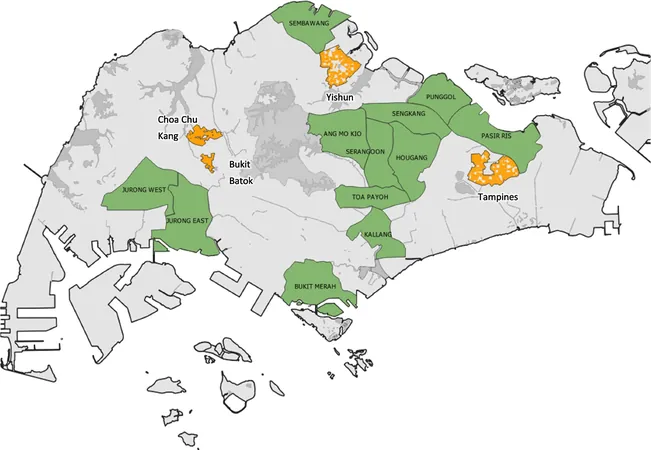
Breakthrough Study Reveals Surprising Efficacy of Wolbachia-Infested Mosquitoes in Fighting Dengue Fever!
2025-03-28
Author: Mei
In-Depth Look at the Innovative Cluster-Randomised Test of Wolbachia's Spillover Effects
Recent groundbreaking research conducted in Singapore has shed light on an unexpected method of combating dengue fever through the release of male mosquitoes infected with the Wolbachia bacterium. This study emulated a cluster-randomised test-negative target trial between epidemiological week (EW) 1 of 2019 and EW 26 of 2022, focusing on the potential spillover efficacy of these altered mosquitoes.
The Experimental Setup
The trial involved the release of Wolbachia-infected *Aedes aegypti* male mosquitoes in selected townships, impacting approximately 607,872 residents. This innovative method employed two key strategies: the incompatible insect technique (IIT) and the sterile insect technique (SIT). The objective was to suppress the wild mosquito population, and it was executed in areas like Bukit Batok and Choa Chu Kang, where specific interventions were tailored according to the local density of dengue cases.
Insightful Outcomes from Gravitrap Analysis
By utilizing Gravitrap indices—an innovative surveillance method that measured the mosquito populace based on the catch rate of female *Aedes aegypti*—the study documented a significant reduction in mosquito numbers in adjacent areas over time. These effects were especially pronounced in Yishun and Tampines, where gradual releases expanded outward to neighboring sectors.
A Rigorous Approach to Data and Randomisation
The research team meticulously selected control sites from 26 townships that had never experienced Wolbachia releases, ensuring robust comparisons. This careful planning involved generating a plethora of random combinations of township pairs to maintain baseline dengue incidence rates and balance between experimental and control arms. Over 133,821 individuals reported suspected dengue illness during this period, with rigorous data collection approved by Singapore's health authorities.
Results that Could Change Global Health Strategies
The study revealed that individuals living in areas adjacent to Wolbachia release sites exhibited a remarkable protective efficacy against dengue fever, averaging 45% to 47% depending on the duration of exposure. This indicated that the drone of these modified mosquitoes extends beyond direct intervention zones.
By age groups, younger individuals (ages 13-19) experienced the highest levels of protective efficacy, while females also showed enhanced protection compared to males. This trend aligns with observations that younger people typically have lower seroprevalence rates and higher susceptibility to dengue.
Statistical Rigor and Sensitivity Analyses
The researchers employed advanced statistical methods—including G-computation and nearest neighbor matching—to assess the spillover effects accurately. The findings remained robust across numerous sensitivity analyses, ensuring that the observations of dengue risk reduction were not coincidental.
Implications Beyond Dengue: A Broader Vector Control Strategy
The results demonstrate that the IIT and SIT approaches used in this study have the potential to not only tackle dengue fever but also address other diseases transmitted by *Aedes aegypti*, such as Zika and chikungunya. This innovative method eliminates the danger of creating resistance in dengue viruses, enabling a sustainable solution for vector control.
Concluding Thoughts: A Paradigm Shift in Mosquito Control
This comprehensive study positions Wolbachia-infested mosquitoes as a promising weapon against dengue fever, paving the way for groundbreaking methods in disease vector control worldwide. It not only illustrates the efficacy of biological interventions in epidemiology but also highlights the essential role of community health in disease prevention. As nations grapple with rising cases of vector-borne illnesses, this research could redefine our battle against diseases historically deemed challenging to suppress. Could this be the turning point in our fight against dengue fever? Only time will tell!



 Brasil (PT)
Brasil (PT)
 Canada (EN)
Canada (EN)
 Chile (ES)
Chile (ES)
 Česko (CS)
Česko (CS)
 대한민국 (KO)
대한민국 (KO)
 España (ES)
España (ES)
 France (FR)
France (FR)
 Hong Kong (EN)
Hong Kong (EN)
 Italia (IT)
Italia (IT)
 日本 (JA)
日本 (JA)
 Magyarország (HU)
Magyarország (HU)
 Norge (NO)
Norge (NO)
 Polska (PL)
Polska (PL)
 Schweiz (DE)
Schweiz (DE)
 Singapore (EN)
Singapore (EN)
 Sverige (SV)
Sverige (SV)
 Suomi (FI)
Suomi (FI)
 Türkiye (TR)
Türkiye (TR)
 الإمارات العربية المتحدة (AR)
الإمارات العربية المتحدة (AR)